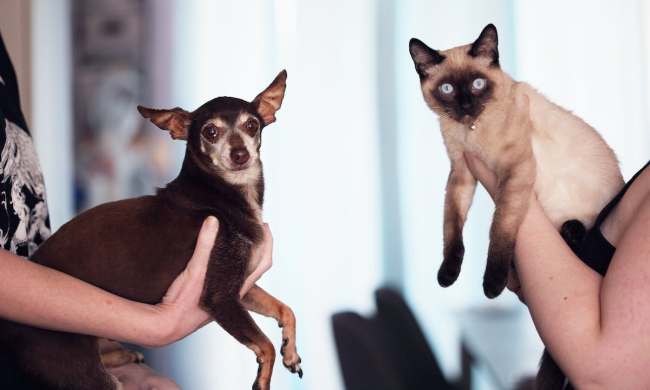With curly-q fur, floppy ears, and tender, round brown eyes, the Cavapoo dog breed is a strong contender for the cutest dog ever. Yet, we’re told not to judge books by their covers or humans by their looks. The same goes for a Cavapoo dog, especially one you hope to make a family member.
The good news? Cavapoos are sweethearts and often make excellent family pets. However, like all dogs, they have needs and are prone to specific health problems. Understanding how to care for one upfront can help you determine whether your home best fits a Cavapoo (or any pet). Here’s what to know about the breed’s physical appearance, health, and personality and tips on “raising one right.”
Cavapoo dog breed: Physical characteristics and health

A Cavapoo is a hybrid of a Cavalier King Charles spaniel and a miniature or toy poodle. These dogs inherit their parent breed’s good looks and a few health risks. Before and while caring for one, you’ll want to understand what’s typical for appearance, shedding, and health. These quick facts will help.
Physical characteristics of a Cavapoo dog
Since Cavapoos are hybrids, they are not recognized by the American Kennel Club and don’t have a specific breed standard. Still, Cavapoo dogs typically display these physical traits.
- Height: 9 to 14 inches (Females are usually shorter than males)
- Weight: 9 to 20 pounds (Males usually weigh more than females)
- Lifespan: 10 to 15 years
- Coat color: Black, brown, chestnut, chocolate, cream, fawn, gold, silver, red, tri-color, and white; coats may be solid or include white markings
- Coat length: Short and curly/wavy
- Hypoallergenic: Yes*
*Technically, no dog is entirely hypoallergenic. A protein in dander and fur can trigger allergies. Some dogs shed less than others. By leaving less fur around a space, these dogs are less likely to trigger allergy symptoms in their human companions.
Cavapoo dog health
A Cavapoo can live a long, healthy life — many live more than 10 years. Regular check-ups and awareness of common health issues can help prevent problems before they occur, preventing discomfort and potentially extending a Cavapoo’s life.
- Mitral valve disease. A congenital heart issue occurs when a valve hasn’t properly developed. A responsible breeder will flag this condition before selling you a pet.
- Syringomyelia. This inherited neurological condition is also seen in Cavalier King Charles spaniels. It affects the spine and can lead to pain and poor posture.
- Luxating patellas. An issue with kneecaps that causes them to move or pop out of place.
- Dry eye. This condition happens when a dog’s eyes don’t produce enough tears. Frequent blinking or rubbing eyes are common symptoms.
- Dental disease. As with humans, poor dental buildup can cause pain and infections.
Cavapoo dog breed personality

A Cavapoo has a truly winning personality. These pets are some of the most affectionate you’ll find, so their sweet looks match their character. All dogs are a little different, but people can generally expect a Cavapoo who is:
- Highly affectionate
- Enjoys cuddles
- Very playful
- Friendly toward strangers
- Good with small children and other animals in the home
- Medium energy with a need for regular, moderate exercise
- Intelligent
- Takes well and quickly to training
- Adapts well to new situations
- Prone to separation anxiety
In other words, if you want a pet that loves snuggles and playtime but won’t drag you for hours-long walks in the dead of winter, a Cavapoo dog breed is a worthy choice.
Caring for a Cavapoo dog

Ensuring your pet receives proper care will bring out the best in them. These best practices for caring for Cavapoos will get you well on your way.
- Grooming. While Cavapoo dogs don’t shed as much as other breeds, their curly coats need more grooming. Plan to brush the dog at least three times weekly and see a groomer every four to six weeks. Regular nail trimmings are also necessary.
- Brush teeth. Brushing your dog’s teeth — daily if possible — keeps dental disease at bay.
- Exercise. A Cavapoo requires regular exercise. Think walks, agility courses, and trips to the dog park.
- Diet. Feed your Cavapoo AAFCO-approved, age-appropriate dog food. Your vet is an excellent resource for choosing the best type.
- Visit the vet. Keep regular appointments with the vet based on your pet’s age and health. Ensuring they are up to date on vaccinations and preventative care goes a long way.
Final thoughts

Members of the Cavapoo dog breed are celebrated for their charming looks and even more lovable personalities. The curly/wavy coats and gigantic brown eyes are rivaled only by the dogs’ love of playing with and snuggling their humans.
A Cavapoo dog is generally excellent with small children and other pets in the home, but you’ll want to follow best practices when introducing and monitoring interactions. The Cavapoo is usually a healthy breed that can live longer than 10 years. However, regular care, such as exercise, feeding a nutritious diet, and vet check-ups, are essential.




